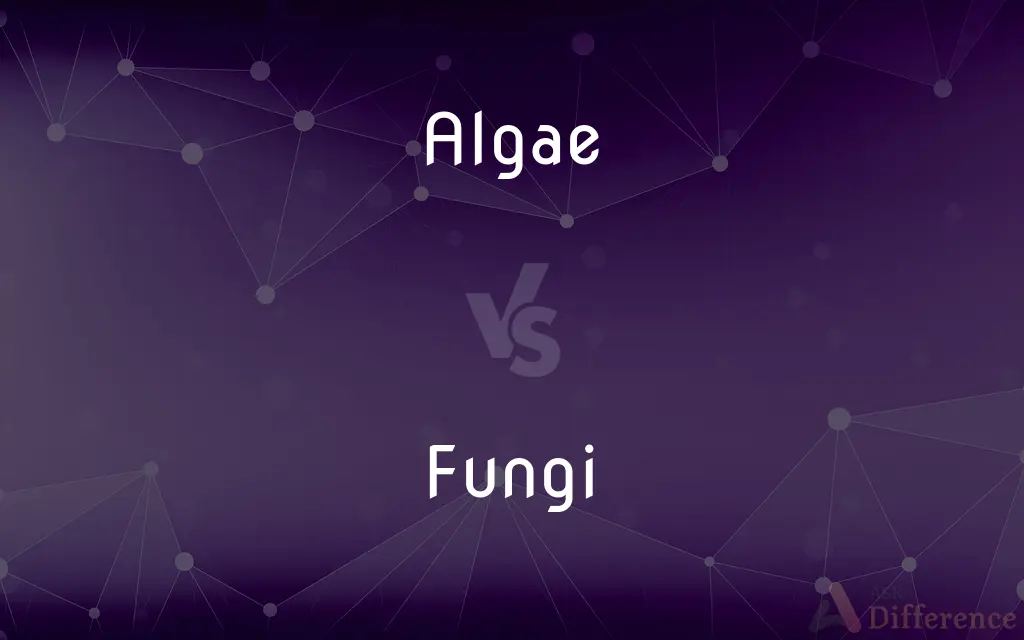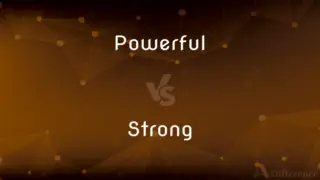Algae vs. Fungi — What's the Difference?
Edited by Tayyaba Rehman — By Fiza Rafique — Updated on September 25, 2023
"Algae" are photosynthetic organisms found in aquatic environments. "Fungi" are non-photosynthetic organisms that decompose organic matter. Both are diverse but fundamentally different in structure and function.

Difference Between Algae and Fungi
Table of Contents
ADVERTISEMENT
Key Differences
Algae predominantly thrive in aquatic ecosystems, both freshwater and marine. They are simple, autotrophic organisms, meaning they produce their own food through the process of photosynthesis. This photosynthetic capability sets them apart from many other organisms. Fungi, in contrast, are heterotrophic, meaning they can't photosynthesize and thus depend on other organic substances for nutrition. Most fungi absorb nutrients from decaying organic matter, making them crucial decomposers in ecosystems.
The cell structure of algae and fungi also varies. Algal cells, especially in green algae, contain chloroplasts that facilitate photosynthesis. Their cell walls typically consist of cellulose or other polysaccharides. Fungi, however, have cell walls primarily made of chitin, a component distinct from the cellulose found in plants and algae.
Reproduction in algae can be both sexual and asexual, involving complex life cycles in some species. Some algae, like kelps, can form large structures but are still simple in cellular organization. Fungi, too, can reproduce sexually and asexually. They often produce spores, which are essential for their dispersal and survival. Fungi, such as mushrooms, can form complex multicellular structures with specialized tissues.
While algae play a significant role in oxygen production and form the base of aquatic food chains, fungi have various ecological roles. Fungi aid in breaking down organic matter, facilitating nutrient cycling. Some fungi form symbiotic relationships with plants, benefiting both organisms, while others can be pathogenic, causing diseases in plants, animals, and even humans.
Comparison Chart
Nutritional Mode
Autotrophic (photosynthetic)
Heterotrophic (absorb nutrients)
ADVERTISEMENT
Cell Wall Composition
Primarily cellulose or other polysaccharides
Chitin
Habitat
Mainly aquatic (freshwater and marine)
Various, including soil, decaying matter, and organisms
Reproduction
Both sexual and asexual
Both sexual and asexual, often via spores
Role in Ecosystem
Oxygen production, base of aquatic food chains
Decomposers, symbionts, or pathogens
Compare with Definitions
Algae
Eukaryotic organisms that can perform photosynthesis.
The growth of algae in oceans contributes to oxygen production.
Fungi
Decomposers that play a vital role in nutrient cycling.
Fungi break down fallen leaves, releasing nutrients back into the soil.
Algae
Photosynthetic organisms mainly found in water.
Seaweeds are a type of marine algae.
Fungi
Eukaryotic organisms with cell walls made of chitin.
Yeasts, used in baking, are single-celled fungi.
Algae
Simple, autotrophic plants without true stems, roots, or leaves.
Pond water often turns green due to the presence of algae.
Fungi
Non-photosynthetic organisms that absorb nutrients from organic matter.
Mushrooms, a type of fungi, can be found growing on decaying wood.
Algae
Base of aquatic food chains, serving as food for various creatures.
Many fishes feed on algae as a primary food source.
Fungi
Producers of spores, aiding in reproduction and dispersal.
Mold on bread is a type of fungi reproducing via spores.
Algae
Diverse group ranging from microscopic phytoplankton to large seaweeds.
Algae blooms can sometimes be harmful to aquatic life.
Fungi
Organisms that can be symbiotic, pathogenic, or saprophytic.
Athlete's foot is caused by a pathogenic fungus.
Algae
Algae (; singular alga ) is an informal term for a large and diverse group of photosynthetic eukaryotic organisms. It is a polyphyletic grouping that includes species from multiple distinct clades.
Fungi
A plural of fungus.
Algae
Any of numerous photosynthetic organisms of aquatic or moist habitats, ranging in size from single-celled diatoms to large seaweeds such as kelp, and characterized by a lack of complex organs and tissues. Once classified within the plant kingdom, the algae are now considered to include several unrelated groups belonging to different kingdoms.
Fungi
(pathology) Spongy, abnormal growth, as granulation tissue formed in a wound.
Algae
Algal organisms viewed collectively or as a mass; algal growth.
Fungi
Alternative spelling of fungee
Algae
(countable) A particular kind of algae.
Fungi
A style of folk and popular music from the Virgin Islands, traditionally performed by bands consisting of banjo, guitar, ukulele, and washboard with various percussion instruments on rhythm.
Algae
Plural of alga.
Fungi
A group of thallophytic plant-like organisms of low organization, destitute of chlorophyll, in which reproduction is mainly accomplished by means of asexual spores, which are produced in a great variety of ways, though sexual reproduction is known to occur in certain Phycomycetes, or so-called algal fungi. They include the molds, mildews, rusts, smuts, mushrooms, toadstools, puff balls, and the allies of each. In the two-kingdom classification system they were classed with the plants, but in the modern five-kingdom classification, they are not classed as plants, but are classed in their own separate kingdom fungi, which includes the phyla Zygomycota (including simple fungi such as bread molds), Ascomycota (including the yeasts), Basidiomycota (including the mushrooms, smuts, and rusts), and Deuteromycota (the fungi imperfecti). Some of the forms, such as the yeasts, appear as single-celled microorganisms, but all of the fungi are are eukaryotic, thus distinguishing them from the prokaryotic microorganisms of the kingdon Monera.
Algae
Primitive chlorophyll-containing mainly aquatic eukaryotic organisms lacking true stems and roots and leaves
Fungi
The taxonomic kingdom of lower plants
Fungi
(pun) the one who buys the drinks
Common Curiosities
Can fungi be beneficial to humans?
Yes, fungi like yeast are used in baking and brewing.
Why are fungi essential for plants?
Many fungi form symbiotic relationships with plants, aiding nutrient absorption.
What role do fungi play in ecosystems?
Fungi are crucial decomposers, breaking down organic matter.
Are mushrooms plants or fungi?
Mushrooms are fungi, distinct from plants.
What's the primary nutritional difference between algae and fungi?
Algae are photosynthetic, while fungi absorb nutrients from organic substances.
Can fungi perform photosynthesis like algae?
No, fungi are non-photosynthetic and rely on external organic matter.
Are all algae microscopic?
No, while some are microscopic (phytoplankton), others like seaweeds are macroscopic.
Is blue-green algae true algae?
No, blue-green algae are cyanobacteria, a type of bacteria.
Are algae considered plants?
While similar, algae are not classified as true plants due to structural differences.
Can algae be harmful?
Yes, certain algae blooms produce toxins that can harm aquatic life and humans.
Do algae only grow in sunlight?
While sunlight aids photosynthesis, some algae can grow in low light or even darkness.
What causes the green color in algae?
The pigment chlorophyll, vital for photosynthesis, gives algae its green color.
Are algae and fungi considered microorganisms?
Some are, like phytoplankton (algae) and yeasts (fungi), but many are macroscopic.
Do fungi have roots like plants?
No, fungi have mycelium and hyphae instead of true roots.
Can fungi grow on living organisms?
Yes, some fungi are parasitic and can infect living plants and animals.
Share Your Discovery

Previous Comparison
Most vs. Must
Next Comparison
Powerful vs. StrongAuthor Spotlight
Written by
Fiza RafiqueFiza Rafique is a skilled content writer at AskDifference.com, where she meticulously refines and enhances written pieces. Drawing from her vast editorial expertise, Fiza ensures clarity, accuracy, and precision in every article. Passionate about language, she continually seeks to elevate the quality of content for readers worldwide.
Edited by
Tayyaba RehmanTayyaba Rehman is a distinguished writer, currently serving as a primary contributor to askdifference.com. As a researcher in semantics and etymology, Tayyaba's passion for the complexity of languages and their distinctions has found a perfect home on the platform. Tayyaba delves into the intricacies of language, distinguishing between commonly confused words and phrases, thereby providing clarity for readers worldwide.
















































